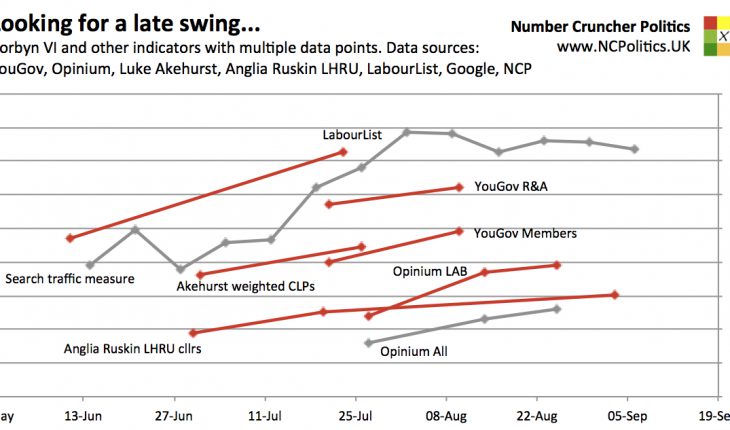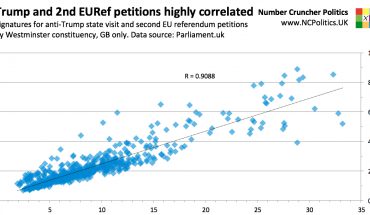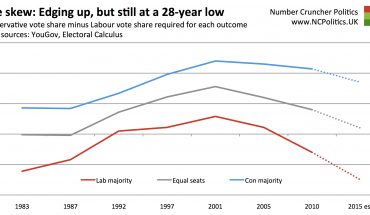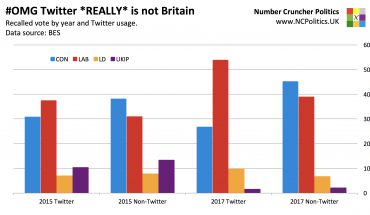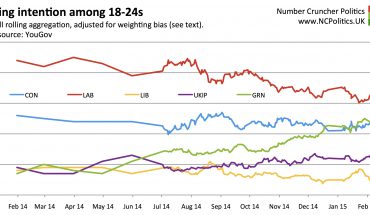When it comes to betting markets, I’m a bit less skeptical than some. The flow of money can contain misleading information, but it can also contain useful information. On this occasion, the flow of money – as illustrated by the odds priced to reflect it – points the same way as all other indicators. The implied probability continues to increase after the second poll spike, as you’d expect given that there’s a decreasing amount of time for something to change.

So there’s no evidence of anything having changed since the YouGov polls – but are the polls right? The one question I’ve been asked more than any other over the last few weeks is whether there’s any sign that YouGov’s Labour leadership polls are wrong. It is very important to stress that, unlike at the general election, there is a very limited array of data to go by, and only two actual polls of the 553,954 person Labour selectorate.
And to repeat what I’ve said before, polling a party selectorate, compared with polling an entire country, is highly non-standard and difficult to do. As far as I’m aware, only YouGov has the capacity to conduct this sort of poll, so it’s great that they’ve stepped up to the plate and done so, particularly at a time when pollsters are under the spotlight.
As I wrote when I first tipped Corbyn in July, CLPs nominations aren’t a bad guide to how members vote, and indeed the second batch of Luke Akehurst’s data equals 44.4% of members, almost perfectly between the members component of the YouGov polls either side of it (40% and 49%).
The other thing to consider is whether there’s any sign of anything suspicious within the detail of polls. YouGov seem to have very good information about the demographics of the full Labour members, and where they’ve had to make assumptions, it sounds from Peter Kellner’s commentary that the risks aren’t tilted towards Corbyn support being overestimated.
But there’s a broader point to be made regarding weighting, as well as sample bias and differential turnout. These threats are greatest when support varies wildly between crossbreaks. But the striking thing about Corbyn support is how broad it appears to be. In the second poll, Corbyn wins decisively among men and women, across age groups, regions and socioeconomic groups, and with each category of voter. Within full members, he loses among the pre-2010 cohort, but not by much. This similarity between subsets of voters greatly reduces the chances of these problems materialising.

To give an example, rumours have been circulating today that turnout in Corbyn’s strongest group, affiliates (mostly unions), has been very poor. Even if this is correct, reweighting the poll from 70% union turnout down to 33% only knocks about two points off Corbyn’s first round share, because he still polls strongly elsewhere.

As I see it, one of the most significant polling concerns from Corbyn’s perspective centres around bias within voter cells that is specific to particular candidates’ supporters. It is possible that Corbyn supporters have been over-represented in the sample through their own enthusiasm, or that there are shy (or simply less enthusiastic) moderates. This is tough to quantify – unlike the general election polls, there is no spiral of silence data.
Interestingly, the proportion of don’t knows dropped from 21% to 12% between the two YouGov polls, at the same time as Cooper, Burnham and Kendall all dropped. That feels like the opposite of what you’d expect if there were shy moderates in the panel, but the data here is far too limited to draw any firm conclusions.
It’s possible too that a disproportionate number of the don’t knows are “anyone but Corbyn” voters, who are undecided between the alternatives, which would mean that excluding them ultimately introduces a bias in Corbyn’s favour.
But there are also ways that the polls could have understated Corbyn. The only thing that we have hard evidence on is the late surge in applications. We know that the initial numbers would have added 4 points to Corbyn’s tally (or three after around 57,000 were removed), provided they were typical. But they might actually be even more Corbyn-inclined than others. The last minute surge in registrations occurred in the immediate aftermath of the second YouGov poll, when all indications were that enthusiasm for Corbyn was higher than at any point previously.
We know that polls can get it wrong. It’s true that these ones could have got it wrong. But I can find no evidence that they actually have got it wrong. Much of the doubt seems to be driven by emotion – wishful thinking by Corbyn’s opponents, “too good to be true” nerves among his supporters, with the events of May continuing to cast a long shadow over anything related to polling.
Part of me wonders whether this #Corbyn surge is like the SNP surge in the sense that the signs are all there, but people won't believe them
— Matt Singh (@MattSingh_) July 26, 2015
Ultimately it comes down to this – unless there has been a loss of support for Corbyn that hasn’t shown up in any data anywhere, the polls would need to be off by three times their error at this year’s general election, more than double their error at the 1992 general election, and almost double their error among Labour members in the 2010 leadership contest.
So to complete the title, there are two things that could stop Corbyn… And there is little evidence of either of them. The likeliest outcome is therefore a decisive Corbyn victory.

